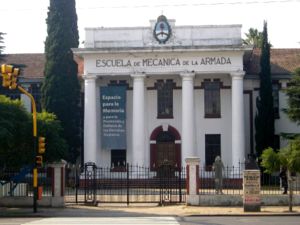- ESMA
-
The Navy Petty-Officers School of Mechanics (in Spanish, Escuela de Suboficiales de Mecánica de la Armada, previously Escuela Superior de Mecánica de la Armada), commonly referred to by its abbreviation ESMA, is a facility of the Argentine Navy that was employed as an illegal detention center during the dictatorial rule of the National Reorganization Process (1976–1983).
While the School was originally a legitimate military teaching institution, this article focuses on its notorious use as a detention center.
The original ESMA was a complex located on Libertador Avenue, in the Autonomous City of Buenos Aires, in the barrio of Nuñez. It was the seat of Task Unit 3.3.2 - Unidad de Tareas 3.3.2,[1] charged with multiple instances of forced disappearance, torture and illegal execution, as well as appropriation of children born to mothers imprisoned there, followed by identity forgery and illegal adoption. ESMA was the largest detention center of its kind during the Dirty War.
The premises of the Mechanics School in Buenos Aires were turned into a museum by law of the National Congress on 5 August 2004, which named it the Space for Memory and for the Promotion and Defense of Human Rights.
The new facilities of the ESMA, again a legitimate military teaching institution, are located in the Puerto Belgrano Naval Base, 28 km from the city of Bahía Blanca.
Contents
Human rights violations
Almost 30,000 people were taken and held in the ESMA, and only 150 lived to tell the story. [2]. Executions were usually announced as "transfers", as if to other prisons. The prisoners were taken to the basement, sedated, and then killed: some by firing squad (their bodies to be cremated in the nearby sports field), others in "death flights", flown over the Río de la Plata and dumped from the airplanes while unconscious.
Functions and authorities
The Mechanics School worked as a detention center from the very start of the dictatorship. On the day of the coup d'état (24 March 1976) several people kidnapped by the Armed Forces were taken there. The officers in charge were under strict orders not to reveal their identities or military affiliation when capturing prisoners.
Task Force 3.2.2 was in charge of the city of Buenos Aires proper and the northern part of the metropolitan area (Gran Buenos Aires). It was led by Rear-Admiral Rubén Jacinto Chamorro and Captain Carlos Acosta Ambone, and among its ranks were Jorge Eduardo Acosta, Alfredo Astiz, Ricardo Miguel Cavallo and Adolfo Scilingo. Its chaplain during 1977 was Father Alberto Ángel Zanchetta.
The group was ultimately (between 1976 and 1978) under the orders of Navy Commander-in-Chief Emilio Eduardo Massera. Massera had reportedly been present during the gathering of the task group, gave an opening speech for the officers, and personally participated in the first illegal detentions.
Layout
The internal layout and conditions of the ESMA has been partly preserved, partly reconstructed from former prisoners' testimonies. Task Force 3.3.2 occupied the officers' mess (casino de oficiales), which had three floors plus a basement and a large attic.
Detainees were held in the basement, the attic and the third floor. The basement was the entry to ESMA for new prisoners, who were taken there for questioning under torture. It included an infirmary and a photographic laboratory. Its layout was modified in October 1977 and again in December 1978, in preparation for the upcoming visit of the Inter-American Commission on Human Rights of the Organization of American States.
The ground floor was called Dorado, and hosted the intelligence and planning area, the officers' dining room, a conference room, and a meeting room. The first and second floors were occupied by the officers' rooms, to which the prisoners had no access.
The area termed Capucha (literally "hood") took up the right-hand side of the attic. It was L-shaped, and had a number of narrow cells (called camarotes, i. e. "cabins") lit only by small casement windows, each containing a mattress for the prisoner.
El Pañol, on the left-hand side of the attic, was the storage room for goods taken from the homes of detainees (furniture, utensils, clothes, etc.). Around the end of 1977 part of the Pañol was dedicated to La Pecera.
La Pecera was a series of small offices, plus a press archive and a library, under the supervision of closed-circuit TV surveillance cameras. Some of the prisoners stayed there part of the day.
Capuchita was a second attic for prisoners, similar to Capucha, but with even worse living conditions. It included two torture rooms. It was lent to the Navy's Intelligence Service, the Army and the Air Force for them to keep and torture their prisoners apart from the others. The Task Force also employed it when Capucha was too crowded.
See also
References
- ^ http://www.derechos.org/nizkor/arg/doc/perren1.html While most English language sources refer to the unit as a 'task force', the attached Spanish webpage gives what appears to the proper name of the unit, named according to U.S. navy task force numbering systems.
- ^ http://www.telegraph.co.uk/culture/3673470/Argentinas-dirty-war-the-museum-of-horrors.html
- Nunca Más, report of CONADEP. ESMA.
External links
Wikimedia Foundation. 2010.

